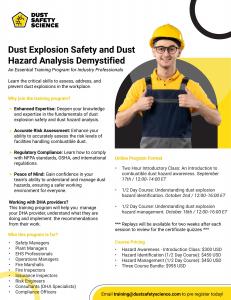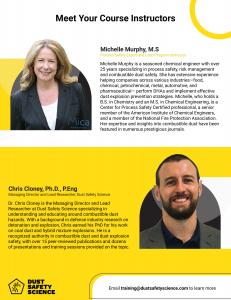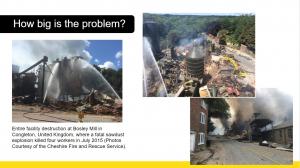Dust Safety Science, presents the 2024 Online Training Course: Understanding Dust Explosion Hazard Analysis
Dust Safety Science, presents the 2024 Online Training Course: Understanding Dust Explosion Hazard Analysis
HALIFAX, NOVA SCOTIA , CANADA, September 26, 2024 /EINPresswire.com/ -- Dust Safety Science is excited to announce the "Understanding Dust Explosion Hazard Analysis" Online Training Program, on October 2nd, 2024, at 12:00–16:00 ETRegister Here: https://dustsafetyscience.com/training-program/
● Half-Day Course
Understanding Dust Explosion Hazard Analysis
Wednesday, October 2nd, 12:00–16:00 ET
Only $450.00 USD
● What will we cover?
Here is a draft outline of what we will cover:
● Part 1: Review of Combustible Dust Testing
Review from last class
Dust Test Decision Tree
Review Granular & Powdered Sugar Dust Example
Review Polyethylene Dust Example
● Part 2: Understanding Dust Hazard Analysis
Section 2.1: How to identify hazards?
Differences between processes and building spaces
Checklist approach to hazard identification
Group exercise
Section 2.2: How to define scenarios?
Evaluating causes and consequences
Understanding worst-case scenarios
Group exercise
Section 2.3: How to evaluate safeguards?
Prescriptive versus Risk-Based evaluation
How to use risk matrices to reevaluate safeguards
Group exercise
Section 2.4: How to make recommendations?
Examples of effective and ineffective recommendations
Reporting process - what to look for
Group exercise
● Part 3: Requested Topics
Section 3.1: Ignition Source Evaluation
How to look out for example ignition sources
Temperature, mechanical, and electrical ignition sources
How to evaluate electrostatic discharge as an ignition source
Case Study Example: Evaluating Ignition Source Hazards
Section 3.2: Fugitive Dust and Building Space Evaluation
Evaluating processes and building compartments
Rules of thumb and guidelines
Minimum layer thickness criteria
Examples: Too Much or Too Little Dust?
Case Study Example: Evaluating Fugitive Dust and Building Compartments
You can register by replying to this email or visit the information page to learn more: https://dustsafetyscience.com/training-program/
Who Should Attend the Training Program?
● Safety Managers
● Plant Managers
● EHS Professionals
● Operations Managers
● Fire Marshalls
● Fire Inspectors
● Insurance Inspectors
● Risk Engineers
● Consultants (DHA Specialists)
● Compliance Officers
Register today for the Half-Day Course:
Understanding Dust Explosion Hazard Analysis
Wednesday, October 2nd, 12:00–16:00 ET
Only $450.00 USD
You can register by replying to this email or visit the information page to learn more: https://dustsafetyscience.com/training-program/
About Dust Safety Science:
● Chris Cloney, Ph.D., P.Eng - Managing Director and Lead Researcher, Dust Safety Science
Dr. Chris Cloney is the Managing Director and Lead Researcher at Dust Safety Science specializing in understanding and educating about combustible dust hazards.
Chris Cloney
Dust Safety Science
Chris@dustsafetyscience
Dr. Chris Cloney
Dust Safety Science
Chris@dustsafetyscience
Visit us on social media:
LinkedIn
YouTube
Other
Legal Disclaimer:
EIN Presswire provides this news content "as is" without warranty of any kind. We do not accept any responsibility or liability for the accuracy, content, images, videos, licenses, completeness, legality, or reliability of the information contained in this article. If you have any complaints or copyright issues related to this article, kindly contact the author above.



